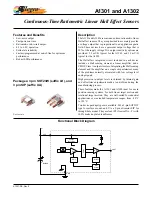
Continuous-Time Ratiometric
Linear Hall Effect Sensors
A1301
and
A1302
4
Allegro MicroSystems, Inc.
115 Northeast Cutoff, Box 15036
Worcester, Massachusetts 01615-0036 (508) 853-5000
www.allegromicro.com
Characteristic Definitions
Quiescent Output Voltage.
In the quiescent state (no sig-
nificant magnetic field: B = 0), the output, V
OUTQ
, equals one
half of the supply voltage, V
CC
, throughout the entire operating
ranges of V
CC
and ambient temperature, T
A
. Due to internal
component tolerances and thermal considerations, there is a
tolerance on the quiescent output voltage,
Δ
V
OUTQ
, which is
a function of both
Δ
V
CC
and
Δ
T
A
. For purposes of specifica-
tion, the quiescent output voltage as a function of temperature,
Δ
V
OUTQ(
Δ
T
A
)
, is defined as:
where Sens is in mV/G, and the result is the device equivalent
accuracy, in gauss (G), applicable over the entire operating tem-
perature range.
Sensitivity.
The presence of a south-polarity (+B) magnetic
field, perpendicular to the branded face of the device package,
increases the output voltage, V
OUT
, in proportion to the magnetic
field applied, from V
OUTQ
toward the V
CC
rail. Conversely, the
application of a north polarity (–B) magnetic field, in the same
orientation, proportionally decreases the output voltage from its
quiescent value. This proportionality is specified as the magnetic
sensitivity of the device and is defined as:
The stability of the device magnetic sensitivity as a function of
ambient temperature,
Δ
Sens
(
Δ
T
A
)
(%) is defined as:
Ratiometric.
The A1301 and A1302 feature a ratiometric
output. This means that the quiescent voltage output, V
OUTQ
,
and the magnetic sensitivity, Sens, are proportional to the supply
voltage, V
CC
.
The ratiometric change (%) in the quiescent voltage output is
defined as:
and the ratiometric change (%) in sensitivity is defined as:
Linearity and Symmetry.
The on-chip output stage is
designed to provide linear output at a supply voltage of 5 V.
Although the application of very high magnetic fields does not
damage these devices, it does force their output into a nonlinear
region. Linearity in percent is measured and defined as:
and output symmetry as:
Δ
V
OUTQ(
ΔΤ
Α
)
Sens
(
25
ºC
)
V
OUTQ(
Τ
Α
)
V
OUTQ(
25
ºC
)
–
=
(1)
2
B
V
OUT(–B)
V
OUT(+B
)
Sens
–
=
Δ
Sens
(
ΔΤ
Α
)
Sens
(
Τ
Α
)
Sens
(
25
ºC
)
Sens
(
25
ºC
)
–
=
× 100
%
(2)
(3)
V
CC
5 V
V
OUTQ(V
CC
)
V
OUTQ(5V)
Δ
V
OUTQ(
Δ
V)
=
× 100
%
(4)
V
CC
5 V
=
× 100
%
Δ
Sens
(
Δ
V
)
Sens
(V
CC
)
Sens
(
5
V
)
(5)
=
× 100
%
Lin
+
2 (
V
OUT(+B½)
– V
VOUTQ
)
–
V
OUT(+B)
V
OUTQ
(6)
=
× 100
%
Lin
–
2(
V
OUT(–B½)
– V
OUTQ
)
–
V
OUT(–B)
V
OUTQ
(7)
–
=
× 100
%
Sym
V
OUT(+B)
V
OUTQ
– V
OUT(–B)
V
OUTQ
(8)









